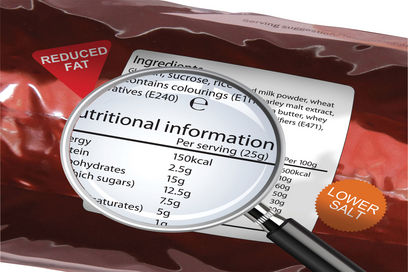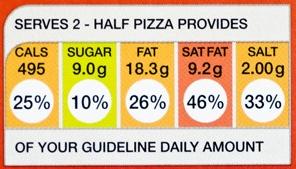“So you think you can read?” …… Really reading food labels
We have food label ‘traffic lights’, RDA’s, RNI’s, guideline daily amounts (GDA’s), portions sizes, good fats, bad fats, simple sugars, refined, unrefined, mono, bio and super foods – no wonder we get confused.
It gets worse…even the attempt by government to help us understand what’s in the (processed) food we buy has been besmirched by clever marketing and wording (an interesting recent article on why a compulsory ‘traffic light system’ never happened http://www.bbc.co.uk/news/health-18767425) So let’s look at what’s really going on and how you can easily work out (roughly, or exactly) what the food you buy is made up of from a calorie, quality and macronutrient (fats, carbohydrate, calories and protein) perspective.
Most of us recognize that some foods now have a Red, Amber or Green color code either as a pie chart (nice pun I thought!) or on the label itself… e.g.
We then blindly go for anything Green over Red or accept Amber as a compromise. All good right? Well it seems there are different Red’s, Amber’s and Greens depending on what ‘They’ think is “proportional” in your diet!? Have a look at this…
You’ll notice the second paragraph appears to say that 188 calories can be good or bad, depending! Not much help really.
So let’s recall the last article and the ‘fundaments’….. all food ends up as one of four energy substrates once metabolized; proteins, carbohydrates (simple sugars or more complex starches), fats or alcohol (which is a sugar and pure source of energy). One gram of each gives up the following:
- Protein = 4 calories
- Carbohydrate = 4 calories
- Fat = 9 calories
- Alcohol = 7 calories (hopefully not in too much food!)
Lets now apply this to really reading a food label. Here are the key things to do when you pick up a pack.
- Look at how many calories are in the food itself. Be careful to take into account that a pack may have SEVERAL servings in it and the label may give values for PER serving! So you may need to multiply by 2 or three or more servings to work out the total amount of calories in the pack.
- Next take the grams of what you are interested in (e.g. fat) and using your knowledge multiply the grams by the calories per gram (e.g. fat at 9 calories per gram multiplied by ‘X’ grams; in the example below that is 13g – so 117 calories from fat). An easier way to get a good rough estimate is to round up and use ‘times’ 10 for fat and 5 for protein and carbohydrate which is a slightly easier calculation on the go.
- Now divide that number into the total calories (e.g. continuing our example below… 117/260 = 45%) to find out exactly what is IN THAT food/pack – as opposed to the percentages given which are based on the arbitrary ‘daily guideline’ NOT the pack of food you are buying.
Here is a full analysis of a food label using this ‘fundamentals approach’
We all recognize we should eat less (calories) but what we often miss looking at the quality of the (processed) food we eat. If you buy a ‘Green’ traffic light food you may discover that it is Green only because the manufacturer decided so based on this guideline daily amount (GDA) or even worse; based on what they considered proportional based on what you might eat!
But you can now discover the true quality of the food you buy through a few simply calculations.
Finally you can use the following as a comparison as to what is high and low (per 100grams) and you will never see a food label in quiet the same way again!
Nutrient A little A lot
Sugar 2g 10g
Fat 3g 20g
Saturated fat 1g 6g
Sodium 0.1g 0.5g
Disclaimer
All content on Silverhairs.com is provided for general information only, and should not be treated at all as a substitute for the medical advice of your own doctor or any other health care professional. Silverhairs.com will not be responsible or liable for any diagnosis made by a user based on the content on www.silverhairs.com and we are also not liable for the content of any external websites or links from or to Silverhairs to any other websites. Please always consult your own doctor if you’re in any way concerned about any aspect of your health.
Pat Fox
Latest posts by Pat Fox (see all)
- Fluid Facts – hydration for health - July 16, 2014
- Oh to sleep ….. - January 29, 2013
- The Heart of the Matter - December 4, 2012
- Exercise is Medicine - October 24, 2012
- The strength of Strength - October 23, 2012
























